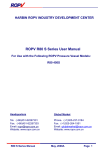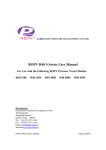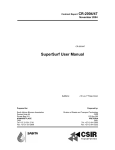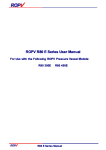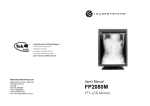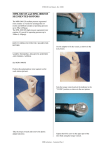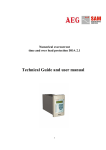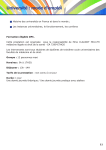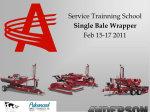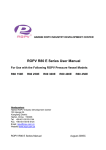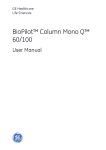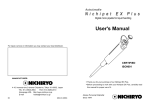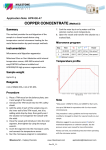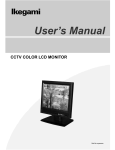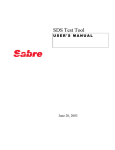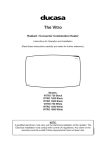Download MDR TECHNOLOGY
Transcript
ETHOS D User Manual - Rev. 0/2001 MDR TECHNOLOGY Milestone patented microwave digestion rotor (MDR) technology provides analysts with unsurpassed performance capabilities and the highest standard of safety in closed vessel microwave digestion. MDR rotors hold multiple microwave digestion vessels in a high strength one-piece “mono-bloc” rotor body. This unique design securely retains sample vessels during microwave digestion and subsequent venting of decomposition gases, for maximum user safety. The digestion vessels used in MDR rotors have no molded or machined threads to be chemically attacked and weakened by acid vapors during vessel venting and opening. This unique feature is an important factor in the durability and safety of Milestone digestion vessels. All digestion vessels in MDR rotors are protected by a patented re-closing (vent and reseal) relief valve mechanism. Vessels fitted into a MDR rotor body are sealed for microwave digestion and proper relief valve functioning using a calibrated torque wrench. The torque wrench ensures vessels are sealed for maximum operating pressure, and will safely vent when a buildup of decomposition gases in excess of vessel’s maximum operating pressure is reached. Microwave digestion of organic samples frequently involves exothermic reactions, which instantaneously generate large amount of decomposition gases (CO2 and NOX) as the sample is oxidized. For proper over pressurization protection of microwave digestion vessels, the venting capacity of the relief device must be equal or higher than the rate of decomposition gas formation. Only Milestone’s relief valve is capable of instantaneously venting excess decomposition gases and resealing the vessel until the digestion procedure is completed. The digested sample is retained inside the vessel for analysis. 7.1 MDR MAJOR COMPONENTS The rotor consists of a high-density polypropylene core in which a number of niches have been “carved” along the periphery by a numerical control machining center. The compact core has the required strength to withstand the extreme pressure generated inside the vessel during digestion. The core tolerates this pressure without any deformation and therefore with high safety. Special plastic compression screws are located on the top of the rotor next to each “niche”. Suitable pressure is applied to the dome-shaped spring holding the cover to the top of the vessel by tightening the screws to the appropriate degree. The dome-shaped, flattop spring is the “heart” of the MDR technology and is made of HTC, a new high-performance plastic. HTC is crystalline and can act as a powerful and very reliable spring. The adapter plate is placed on top of the cover. Made of a plastic with high resistance to mechanical compression, it allows a very homogeneous and repeatable distribution of the preset pressure limit. The cover has a flat bottom rim and perfectly fits the top rim of the vessel. Sealing between cover and vessel takes place on a very large surface area without any intermediate seal ring, which could deteriorate in contact with acid vapors. The elimination of a threaded cover prevents all problems connected with thread deformation or impurities on threads. The vessel has normally a volume of 100 mL. A high resistant HTC safety shield prevents lateral deformation of the vessel. MDR technology - Monobloc Page 1 ETHOS D User Manual - Rev. 0/2001 MATERIALS USED FOR THE MANUFACTURE OF MDR VESSELS AND SAFETY SHIELDS TFM TEFLON TFM is often used for the manufacture of covers and vessels of the MDR rotors. TFM is a Hoechst trade name for chemically modified PTFE. TFM Teflon has a very dense structure with smooth surface and low permeability to gases and vapors. TFM Teflon is chemically inert to most mineral acids and combinations thereof. It is a thermal insulator, with a very high stability to temperature extremes. TFM Teflon is microwave transparent. Its maximum working temperature for extended use is 260°C, for short time 300°C. The melting range is 320-340°C. PFA TEFLON PFA is often used for the manufacture of vessels of the MDR rotors. PFA Teflon is a melt-processable fluoroplastic material, which can be extruded and therefore manufactured in relatively low-cost vessels. It shows a good all-round chemical resistance. It is microwave transparent and thermal insulator. The maximum working temperature is around 220°C; the melting temperature is about 300°C. HTC plastics are used for the manufacture of safety spring, adapter plate and safety shield. They are characterized by the sequence ether-etherketon-keton. When HTC are used for the safety shield they are reinforced with glass fiber. HTC have high mechanical strength to high temperatures and good chemical resistance. The maximum service temperature for extended use is 250°C. MDR SAFETY The drawing below clearly show the instantaneous release of overpressure due to the deformation of the HTC safety spring. The figure at left represents a vessel in normal working conditions. When pressure increases over the maximum spring working pressure (figure in the center), the entire cover is allowed to lift up because of the elastic deformation of the safety spring. The overpressure is instantaneously released thanks to the large surface area. The larger the surface area the shorter the time required to release the pressure. Once the pressure inside the vessel has returned within the vessel limit, the cover reseals the vessel, permitting the operator to continue with the acid digestion without any loss (figure at right). HTC MDR technology - Monobloc Page 2 ETHOS D User Manual - Rev. 0/2001 This is the unique operating principle of the microwave digestion rotor technology of Milestone. An indicator ring located next to the cover remains in the upper position in case of vessel venting. The picture shows at right a vessel in normal conditions and at left a vessel after venting. MDR-1000/6S therefore most analytical balances may be used for the purpose (picture). Tare the vessel and directly weigh the sample by placing it inside the vessel (picture). Try to reduce as much as possible sample transfer, to avoid any contamination. Introduce the TFM Teflon vessel into the HTC protection shield. The MDR-1000/6S high pressure rotor contains 6 vessels for acid digestion of routine and difficult samples at operating pressure up to 100bar (1.450psi). HOW TO OPERATE WITH THE MDR-1000/6S ROTOR SAMPLE WEIGHING, REAGENTS ADDITION AND VESSEL CAPPING Place a TFM Teflon vessel directly on the balance plate. The weight of the TFM Teflon vessel is about 120g, WARNING The wall surfaces of the HTC protection shield as well as the outer wall of the TFM Teflon vessel must be dry and clean. Damages may occur otherwise! MDR technology - Monobloc Page 3 ETHOS D User Manual - Rev. 0/2001 Add suitable reagents to the sample. When part of the sample is left on the inner wall of the TFM Teflon vessel, try to wet it by adding acids drop by drop (picture). Gently swirl the solution, to homogenize the sample with the acid. Place the TFM Teflon cover on the TFM Teflon vessel. Push it by end and check that the cover fits well onto the vessel (picture). Now put the TFM Teflon indicator ring on the cover and push it down completely, until it fits the groove of the HTC safety shield, as shown by the next picture. Position the polypropylene rotor body on the work station (picture). Place now the HTC adapter plate on the TFM Teflon cover, with the flat part of it at facing downwards, to have the space for the HTC safety spring on the top side (picture). Place the HTC safety spring onto the HTC adapter plate (picture). Introduce the vessel vertically into one of the numbered niches carved along the periphery of the 6-position polypropylene rotor body. MDR technology - Monobloc Page 4 ETHOS D User Manual - Rev. 0/2001 Notice the position of the venting hole located in the TFM Teflon indicator ring. The hole must face outside, so that in case of venting no hot acid vapors can damage the polypropylene rotor body (picture). Repeat the same operations for the remaining nine vessels; then put the external protection ring around the rotor body (picture). It may be useful now to fix the vessel inside its location, without a complete closing. Take the torque wrench and remove the plastic adaptor (picture). Take the torque wrench and set the indicator to the “CLOSE” position, as shown in the next picture. Use the adaptor to fix the vessels, as shown in the next picture. Tighten the HTC screw in the upper part of the rotor body using the torque wrench. Make long rotations (refer to the two next pictures) instead of short ones and do proceed slowly until you hear a clicking sound informing that the vessel is properly closed inside its niche. WARNING Stop turning the torque wrench when the click is heard. In fact the torque wrench may overload the HTC safety spring if further rotation is applied. MDR technology - Monobloc Page 5 ETHOS D User Manual - Rev. 0/2001 Make slow 90° rotations with the torque wrench, to get a better control of the correct closing of the vessel (click sound). Slide-in the MDR-1000/6S rotor inside the microwave cavity of the ETHOS (picture). Turn the rotor until it matches the drive adaptor located at the center of the microwave cavity base (picture). The MDR-1000/6S rotor is now ready to be introduced inside the ETHOS; open the door of the microwave unit by pressing down the door handle (picture). MDR technology - Monobloc Page 6 ETHOS D User Manual - Rev. 0/2001 Close the door of the ETHOS (picture). Switch on the ETHOS (picture) and start a suitable microwave acid digestion program. MDR technology - Monobloc Page 7 ETHOS D User Manual - Rev. 0/2001 SETUP OF THE REFERENCE VESSEL, USED FOR TEMPERATURE CONTROL Notice the reference cover, provided with one port, and the thermowell. The thermowell is made of ceramic, and it is Teflon coated to avoid any sort of damage. Push the HTC screw, along with the TFM sealing ring and the ceramic thermowell, until the HTC screw is in contact with the TFM Teflon cover. Slide-in the thermowell into the Teflon cover. The open end of the thermowell should be of course left in the upper part of the Teflon cover, to allow the subsequent introduction of the thermocouple. Use the HTC tool supplied to tighten the HTC screw into the TFM Teflon cover, as shown by the next picture. Introduce the TFM Teflon sealing ring, as shown by the next picture. Locate now the HTC fixing screw onto the TFM Teflon sealing ring. MDR technology - Monobloc Page 8 ETHOS D User Manual - Rev. 0/2001 The HTC screw should remain approximately 1 mm above the surface of the TFM Teflon cover. The setup of the reference cover for temperature control is not a routine operation, so it must be carried out only once. It is however important to check regularly that the HTC screw does not feel loose on the TFM Teflon cover. It is therefore recommended to tighten the HTC screw from time to time. Furthermore, whenever the HTC screw shows signs of corrosion, typically a yellowish color, remove it from the TFM Teflon cover and replace it along with the TFM Teflon sealing ring. The vessel used for temperature control should contain the same sample, the same sample size and the same reagent as the remaining vessels, as this vessel is used as reference. ☞ the HTC adapter plate has to match the indentation of the TFM Teflon cover; you will notice also that the HTC screw will match the grove machined in the bottom part of the TFM Teflon cover. Put the special HTC safety spring onto the HTC adapter plate. The reference HTC spring differs from the others; it has a smaller diameter to allow the introduction of the thermocouple into the vessel. WARNING It is recommended to use at least 8 mL of solution inside the vessel, to allow the temperature sensor to be in contact with the liquid. Place the reference cover onto the vessel, as shown by the next picture. Introduce the reference vessel just assembled into the position number one of the rotor. The special HTC adapter plate goes on the reference TFM Teflon cover. The indentation of MDR technology - Monobloc Page 9 ETHOS D User Manual - Rev. 0/2001 Put the protection ring around the rotor body. Tighten the reference vessel in the same way as the other vessels. Take the torque wrench and set the indicator to the “close” position, as shown in the next picture. Introduce now the thermocouple into the reference vessel, simply sliding-in the sensor through the hole in the HTC screw of the rotor. Tighten the HTC screw in the upper part of the rotor body using the torque wrench. Make long rotations instead of short ones and do proceed slowly until you hear a clicking sound informing that the vessel is properly closed inside its niche. ☞ WARNING Stop turning the torque wrench when a click is heard. In fact the torque wrench may overload the HTC safety springs if further rotation is applied. Detail of the upper part of the rotor. Notice the hole for the thermocouple. This is aligned with the thermowell, therefore allowing the temperature sensor to be fully introduced in the vessel. Fully introduce the temperature sensor into the thermowell, until the snap connector is fixed. MDR technology - Monobloc Page 10 ETHOS D User Manual - Rev. 0/2001 A beep sound will be heard. Plug-in now the temperature sensor. Bend the temperature sensor as shown by the next picture. This positioning of the rotor and of the sensor is now correct. The rotor is now ready to be introduced inside the ETHOS; open the door of the microwave unit and introduce the rotor into the cavity. Gently turn the rotor until it matches the HTC rotor drive located in the center of the microwave cavity bottom. Close the door of the ETHOS and start a digestion program (refer to the Milestone cookbook). Unplug the jumper of the ATC-400 Automatic Temperature Control device of the ETHOS. COOLING DOWN AND UNCAPPING THE VESSEL Once the digestion program is completed, high temperature and pressure are reached inside the vessels, according with the sample preparation procedure applied. It is therefore necessary to cool down the rotor before opening the vessels. To facilitate this operating step Milestone has developed a cooling system able to reduce the cooling time to about 10 minutes. For the monobloc rotor, Introduce the rotor body complete with vessels and protection ring inside the cooling system (picture above). MDR technology - Monobloc Page 11 ETHOS D User Manual - Rev. 0/2001 For segmented rotor, introduce the individual segements. Put the cover back on the cooling system itself (picture). Turn off the water supply and move the rotor body from the cooling system to the work station, preferably located under a fume hood. Dry with the utmost care rotor and vessels prior uncapping. Take the torque wrench and set the indicator to the “OPEN” position, as shown in the next picture. Turn on the water supply and let the water flow in for approximately 10-15 minutes (picture). Place the rotor complete with vessels on the work station, located under a fume hood. Carefully loosen the screw in the upper part of the rotor body, by using the tension wrench. Open vessels very slowly, since a certain pressure may still be present (depending on sample type) even if temperature is as low as room temperature. Open the vessel opposite to your position, as shown by the next two pictures. Get a good control of the opening step rotating the torque wrench with wide angles. MDR technology - Monobloc Page 12 ETHOS D User Manual - Rev. 0/2001 Take the vessels out of the rotor body (picture). Carefully take up the vessel cover together with the TFM Teflon protection ring (picture). Remove the external protection (picture). Rinse the lower part of the TFM Teflon cover with distilled water, collecting the same inside the vessel (picture). MDR technology - Monobloc Page 13 ETHOS D User Manual - Rev. 0/2001 Slide the TFM Teflon vessel out of the HTC protection shield (picture). Pour the solution in a laboratory volumetric flask, washing repeatedly the TFM Teflon vessel with distilled water (picture). Repeat the same operation with all vessels in the rotor. Your samples are now ready to be analyzed. MDR technology - Monobloc Page 14














